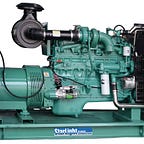What Is the Difference between DC Motor and AC Motor
AC MOTOR
The AC electric motor’s stator has coils that are supplied with the alternating current and produces a rotating magnetic field. The AC electric motor’s rotor rotates inside the electric motor’s coils and is attached to an output shaft that produces torque by the rotating magnetic field. There are two different types of AC electric motors and each of them uses a different type of rotor. The first type of AC motor is called an induction motor (also known as an asynchronous motor).
An induction motor uses a magnetic field on the rotor of an induction motor that’s created by an induced current. The other type of AC motor is called a synchronous motor and rotates precisely at the supply frequency or on a sub-multiple of the supply frequency.
A synchronous motor is able to operate with precision supply frequency because it doesn’t reply on induction. The magnetic field on a synchronous motor is generated by current delivered through slip rings or a permanent magnet. Synchronous motors run faster than induction motors because the speed is reduced by the slip of the asynchronous motor.
DC MOTOR
DC electric motors are powered from direct current (DC) power and are mechanically commutated machines. DC electric motors have a voltage induced rotating armature winding, and a non-rotating armature field frame winding that is a static field, or permanent magnet.
DC electric motors use different motor connections of the field and armature winding to produce different speed and torque regulation. Unlike AC electric motors, DC electric motor speed can be controlled within the winding by changing the voltage applied to the DC motor armature, or by adjusting the field frame current.
Most DC electric motors today are manufactured to be controlled with industrial electronic DC drives. DC electric motors are still used in many applications across the globe such as paper producing machines, and steel mill rolling machines.
CONCLUSION
DC motors are usually seen in applications where the motor speed needs to be externally controlled. AC motors work best in applications where power performance is sought for extended periods of time. All DC motors are single phase, but AC motors can be single phase or three phase.
AC and DC motors use the same principle of using an armature winding and magnetic field except with DC motors, the armature rotates while the magnetic field doesn’t rotate. In AC motors the armature does not rotate and the magnetic field continuously rotates.
In some applications today, DC electric motors are replaced by combining an AC electric motor with an electronic speed controller, known as variable frequency drive. DC electric motors are replaced with an AC electric motor and an electronic speed controller because it is a more economical and less expensive solution.
DC electric motors have many moving parts that are expensive to replace, and DC electric motor repair is usually more expensive than using a new AC electric motor with an electronic controller.
So as far as maintenance is concern, AC motors are used most as easy availability of AC supply DC motor has constant maintenance problem.
DC motor advantages:
1. The starting and speed regulation performance is good, the speed regulation range is wide and smooth, the overload capability is strong, and the electromagnetic interference is small;
2. DC motor has good starting characteristics and speed regulation characteristics;
3, DC motor torque is relatively large
4, the maintenance is relatively cheap;
5. DC of DC motor is more energy-saving and environmentally friendly than AC.
DC motor disadvantages:
1, DC motor manufacturing is more expensive, there are carbon brushes;
2. Compared with asynchronous motors, DC motors have complex structures, are inconvenient to use and maintain, and require DC power supplies;
3. The complicated structure limits the further reduction of the volume and weight of the DC motor, especially the sliding contact between the brush and the commutator causes mechanical wear and sparks, which makes the DC motor have many faults, low reliability, short life and maintenance. The maintenance workload is large.
4. The reversing spark not only causes the electric corrosion of the commutator, but also a radio interference source, which will have harmful effects on the surrounding electrical equipment. The larger the capacity of the motor and the higher the speed, the more serious the problem. Therefore, the brush and commutator of the ordinary DC motor limit the development of the DC motor to high speed and large capacity.
